4.2: Slope of Tangent Line
- Page ID
- 1243
\( \newcommand{\vecs}[1]{\overset { \scriptstyle \rightharpoonup} {\mathbf{#1}} } \)
\( \newcommand{\vecd}[1]{\overset{-\!-\!\rightharpoonup}{\vphantom{a}\smash {#1}}} \)
\( \newcommand{\id}{\mathrm{id}}\) \( \newcommand{\Span}{\mathrm{span}}\)
( \newcommand{\kernel}{\mathrm{null}\,}\) \( \newcommand{\range}{\mathrm{range}\,}\)
\( \newcommand{\RealPart}{\mathrm{Re}}\) \( \newcommand{\ImaginaryPart}{\mathrm{Im}}\)
\( \newcommand{\Argument}{\mathrm{Arg}}\) \( \newcommand{\norm}[1]{\| #1 \|}\)
\( \newcommand{\inner}[2]{\langle #1, #2 \rangle}\)
\( \newcommand{\Span}{\mathrm{span}}\)
\( \newcommand{\id}{\mathrm{id}}\)
\( \newcommand{\Span}{\mathrm{span}}\)
\( \newcommand{\kernel}{\mathrm{null}\,}\)
\( \newcommand{\range}{\mathrm{range}\,}\)
\( \newcommand{\RealPart}{\mathrm{Re}}\)
\( \newcommand{\ImaginaryPart}{\mathrm{Im}}\)
\( \newcommand{\Argument}{\mathrm{Arg}}\)
\( \newcommand{\norm}[1]{\| #1 \|}\)
\( \newcommand{\inner}[2]{\langle #1, #2 \rangle}\)
\( \newcommand{\Span}{\mathrm{span}}\) \( \newcommand{\AA}{\unicode[.8,0]{x212B}}\)
\( \newcommand{\vectorA}[1]{\vec{#1}} % arrow\)
\( \newcommand{\vectorAt}[1]{\vec{\text{#1}}} % arrow\)
\( \newcommand{\vectorB}[1]{\overset { \scriptstyle \rightharpoonup} {\mathbf{#1}} } \)
\( \newcommand{\vectorC}[1]{\textbf{#1}} \)
\( \newcommand{\vectorD}[1]{\overrightarrow{#1}} \)
\( \newcommand{\vectorDt}[1]{\overrightarrow{\text{#1}}} \)
\( \newcommand{\vectE}[1]{\overset{-\!-\!\rightharpoonup}{\vphantom{a}\smash{\mathbf {#1}}}} \)
\( \newcommand{\vecs}[1]{\overset { \scriptstyle \rightharpoonup} {\mathbf{#1}} } \)
\( \newcommand{\vecd}[1]{\overset{-\!-\!\rightharpoonup}{\vphantom{a}\smash {#1}}} \)
\(\newcommand{\avec}{\mathbf a}\) \(\newcommand{\bvec}{\mathbf b}\) \(\newcommand{\cvec}{\mathbf c}\) \(\newcommand{\dvec}{\mathbf d}\) \(\newcommand{\dtil}{\widetilde{\mathbf d}}\) \(\newcommand{\evec}{\mathbf e}\) \(\newcommand{\fvec}{\mathbf f}\) \(\newcommand{\nvec}{\mathbf n}\) \(\newcommand{\pvec}{\mathbf p}\) \(\newcommand{\qvec}{\mathbf q}\) \(\newcommand{\svec}{\mathbf s}\) \(\newcommand{\tvec}{\mathbf t}\) \(\newcommand{\uvec}{\mathbf u}\) \(\newcommand{\vvec}{\mathbf v}\) \(\newcommand{\wvec}{\mathbf w}\) \(\newcommand{\xvec}{\mathbf x}\) \(\newcommand{\yvec}{\mathbf y}\) \(\newcommand{\zvec}{\mathbf z}\) \(\newcommand{\rvec}{\mathbf r}\) \(\newcommand{\mvec}{\mathbf m}\) \(\newcommand{\zerovec}{\mathbf 0}\) \(\newcommand{\onevec}{\mathbf 1}\) \(\newcommand{\real}{\mathbb R}\) \(\newcommand{\twovec}[2]{\left[\begin{array}{r}#1 \\ #2 \end{array}\right]}\) \(\newcommand{\ctwovec}[2]{\left[\begin{array}{c}#1 \\ #2 \end{array}\right]}\) \(\newcommand{\threevec}[3]{\left[\begin{array}{r}#1 \\ #2 \\ #3 \end{array}\right]}\) \(\newcommand{\cthreevec}[3]{\left[\begin{array}{c}#1 \\ #2 \\ #3 \end{array}\right]}\) \(\newcommand{\fourvec}[4]{\left[\begin{array}{r}#1 \\ #2 \\ #3 \\ #4 \end{array}\right]}\) \(\newcommand{\cfourvec}[4]{\left[\begin{array}{c}#1 \\ #2 \\ #3 \\ #4 \end{array}\right]}\) \(\newcommand{\fivevec}[5]{\left[\begin{array}{r}#1 \\ #2 \\ #3 \\ #4 \\ #5 \\ \end{array}\right]}\) \(\newcommand{\cfivevec}[5]{\left[\begin{array}{c}#1 \\ #2 \\ #3 \\ #4 \\ #5 \\ \end{array}\right]}\) \(\newcommand{\mattwo}[4]{\left[\begin{array}{rr}#1 \amp #2 \\ #3 \amp #4 \\ \end{array}\right]}\) \(\newcommand{\laspan}[1]{\text{Span}\{#1\}}\) \(\newcommand{\bcal}{\cal B}\) \(\newcommand{\ccal}{\cal C}\) \(\newcommand{\scal}{\cal S}\) \(\newcommand{\wcal}{\cal W}\) \(\newcommand{\ecal}{\cal E}\) \(\newcommand{\coords}[2]{\left\{#1\right\}_{#2}}\) \(\newcommand{\gray}[1]{\color{gray}{#1}}\) \(\newcommand{\lgray}[1]{\color{lightgray}{#1}}\) \(\newcommand{\rank}{\operatorname{rank}}\) \(\newcommand{\row}{\text{Row}}\) \(\newcommand{\col}{\text{Col}}\) \(\renewcommand{\row}{\text{Row}}\) \(\newcommand{\nul}{\text{Nul}}\) \(\newcommand{\var}{\text{Var}}\) \(\newcommand{\corr}{\text{corr}}\) \(\newcommand{\len}[1]{\left|#1\right|}\) \(\newcommand{\bbar}{\overline{\bvec}}\) \(\newcommand{\bhat}{\widehat{\bvec}}\) \(\newcommand{\bperp}{\bvec^\perp}\) \(\newcommand{\xhat}{\widehat{\xvec}}\) \(\newcommand{\vhat}{\widehat{\vvec}}\) \(\newcommand{\uhat}{\widehat{\uvec}}\) \(\newcommand{\what}{\widehat{\wvec}}\) \(\newcommand{\Sighat}{\widehat{\Sigma}}\) \(\newcommand{\lt}{<}\) \(\newcommand{\gt}{>}\) \(\newcommand{\amp}{&}\) \(\definecolor{fillinmathshade}{gray}{0.9}\)Kevin is learning about the basis of calculus and what calculus is actually used for. Unfortunately, Kevin does not understand why calculus is sometimes necessary to find the equation of a line. In Algebra 1, he learned you can find the equation of a line if you are given two points. You find the slope of the line by dividing the up/down difference in the points by the left/right difference, then you use one of the points and the slope to find the y-intercept.
Kevin's teacher, Mr. Banner, offered him extra credit if he could find the slope of a line for the points (4,5) and (4,5) using the method he learned in Algebra 1. Can you see what Mr. Banner did? What is Kevin going to find as he works on those problems?
Tangents to a Curve
Recall from algebra, if points P(x0,y0) and Q(x1,y1) are two different points on the curve y = f(x), then the slope of the secant line connecting the two points is given by

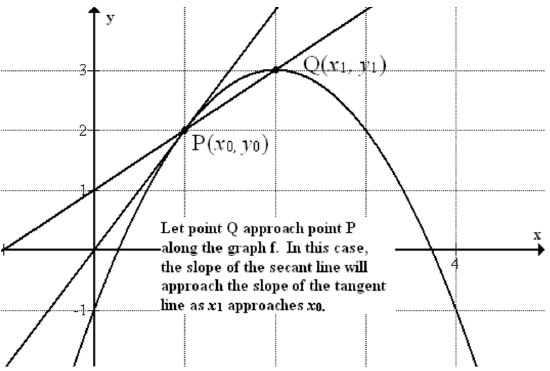
Of course, if we let the point x1 approach xo then Q will approach P along the graph f and thus the slope of the secant line will gradually approach the slope of the tangent line as x1 approaches x0. Therefore, (1) becomes

To simplify our notation, if we let h = x1 − x0, then x1 = x0 + h and x1 → x0 becomes equivalent to h → 0. This means that (2) becomes

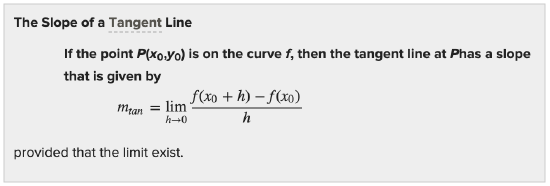
Recall that the equation of the tangent line through point (x0, y0) with slope m is the point-slope form of a line: y − y0 = mtan(x − x0).
Examples
Example 1
Earlier, you were given a problem about Kevin, who is having trouble understanding calculus.
Mr. Banner asked Kevin to find the equation of a line given the points (4,5) and (4,5). The points (4, 5) and (4, 5) are the same, so the rise/run would be 00 - Kevin was just introduced to the need for differential calculus!
Example 2
Find line tangent to the curve f(x) = x3 that passes through point P (2,8).
Since P(x0, y0) = (2, 8), using the slope of the tangent equation we have
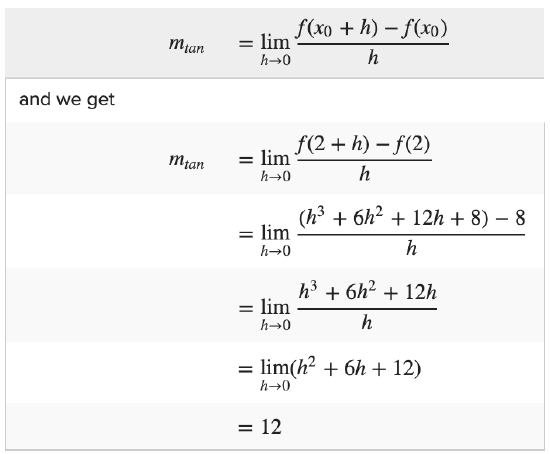
Thus the slope of the tangent line is 12. Using the point-slope formula above, we find that the equation of the tangent line is y - 8 = 12 (x - 2) or y = 12x - 16.
Example 3
If f(x) = x2 − 3,find f' (x) and use the result to find the slope of the tangent line at x = 2 and x = −1.
Since  then
then
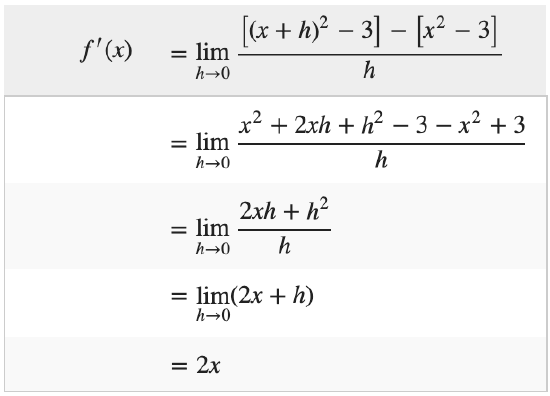
To find the slope, we simply substitute x = 2 into the result f' (x):

and
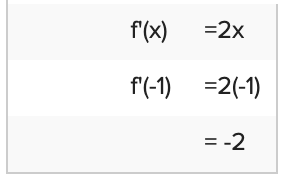
Thus slope of the tangent line at x = 2 and x = −1 are 4 and −2 respectively.
Example 4
Find the slope of the tangent line to the curve y = 1/x that passes through the point (1, 1).
Using the slope of the tangent formula,
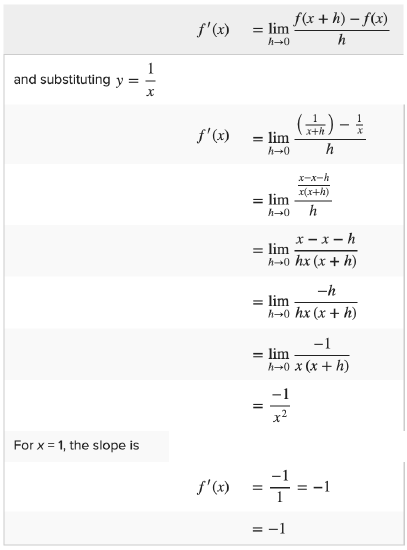
Thus the slope of the tangent line at x = 1 for the curve y = 1/x is m = −1. To find the equation of the tangent line, we simply use the point-slope formula,
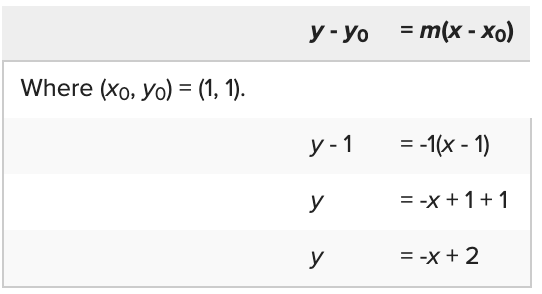
So the equation of the tangent line is y = -x + 2.
Example 5
Given the function y=1/2x2 and the values of x0=3 and x1=4, find:
- The average rate of change of y with respect to x over the interval [x0, x1].
Identify the two points by substituting 3 and 4 in for x in the function f(x)=1/2x2
Substitute the two points (3, 4.5) and (4, 8) into the average rate of change formula: m=y1−y0/x1−x0
Average rate of change = 7/2
- The slope of the secant line connecting x0 and x1.
The slope of the secant line between x0 and x1 is the slope between (3,4.5) and (4,8), which is 72.
- The instantaneous rate of change of y with respect to x at x0.
Instantaneous rate of change is the slope at x = 3.
Use the formula: f(x+h)−f(x)/h where f(x)=1/2x2 and x=3
f(3+h)−f(3)/h ..... Substitute 3 for x
0.5(3+h)2−0.5(3)2/h ..... Replace f(x)→1/2x2

FOIL and Distribute the 1/2
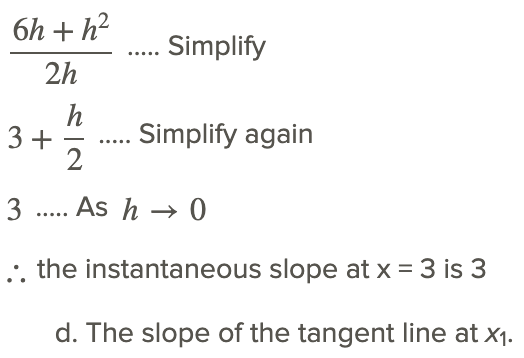
The slope of the tangent at 4 is the same as the instantaneous rate of change at x=4
This is the same series of steps as with x = 3 above
∴ the slope at x = 4 is 4
Example 6
Given the function f(x)=1x and the values x0=2 and x1=3, find:
- The average rate of change of y with respect to x over the interval [x0, x1].
Identify the two points by substituting 2 and 3 in for x in the function

Substitute the two points (2,1/2)|(3,1/3) into the average rate of change formula: m=y1−y0/x1−x0
Average rate of change = −16
- The slope of the secant line connecting x0 and x1.
The slope of the secant line between x0 and x1 is the slope between (2,1/2) and (3,1/3), which is −16.
- The instantaneous rate of change of y with respect to x at x0.
Instantaneous rate of change at x0 is the slope at x= 2.
Use the formula: f(x+h)−f(x)/h where f(x)=1/x and x=2
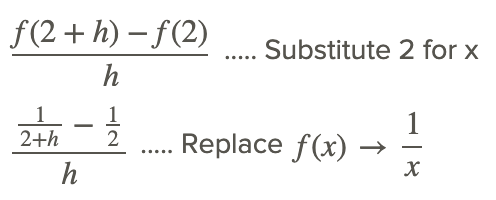
 We had a fraction divided by a fraction, invert to multiply
We had a fraction divided by a fraction, invert to multiply
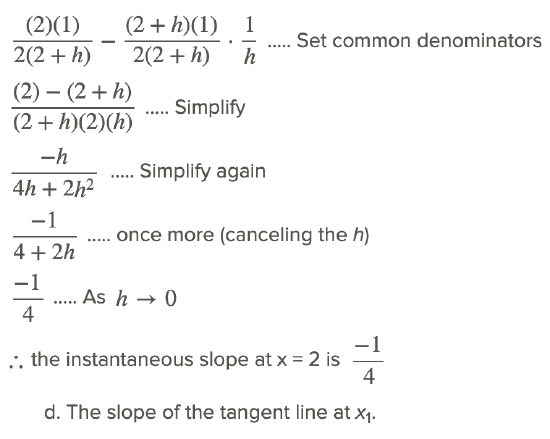
The slope of the tangent at 3 is the same as the instantaneous rate of change at x=3
This is the same series of steps as with x = 2 above
∴ the slope at x = 3 is −1/9
Review
- What is the line connecting two points (x0,y0) and (x1,y1) on a curve called?
- As (x0,y0) gets immeasurably close to (x1,y1) the term describing the line between them becomes: "the ____________ line"
- The expression f(x0+h)−f(x0) is used to describe what distance in the process of finding the slope of a tangent line?
- When calculating the slope of a tangent, what value is assumed to go to 0 as the two chosen points get closer and closer?
- What does the concept of limit, discussed in prior lessons, have to do with finding the slope of a line tangent to a curve?
Find the equation of the tangent line:
- What is the equation of the tangent line at x=−3 assuming that r(−3)=−5 and r′(−3)=1?
- What is the equation of the tangent line at x=1 assuming that r(1)=3 and r′(1)=−5?
- What is the equation of the tangent line at x=2 assuming that g(2)=1 and g′(2)=−3?
- What is the equation of the tangent line at x=4 assuming that u(4)=4 and u′(4)=3?
- What is the equation of the tangent line at x=−4 assuming that t(−4)=2 and t′(−4)=5?
Find the equation of the tangent line:
- Find the equation of the tangent line to the graph of h(x)=−5x3−3x2+x+3 at x=1
- Find the equation of the tangent line to the graph of t(x)=−2x at x=−2
- Find the equation of the tangent line to the graph of m(x)=3x3+3x2+4x+4 at x=1
- Find the equation of the tangent line to the graph of q(x)=−x3−4x2+4x+3 at x=−2
- Find the equation of the tangent line to the graph of t(x)=−4x2+2x−4 at x=−1
- Find the equation of the tangent line to the graph of h(x)=−4x3+2x2−3x+3 at x=−1
- Find the equation of the tangent line to the graph of m(x)=x at x=0
- Find the equation of the tangent line to the graph of s(x)=−3x2−2x+3 at x=0
- Find the equation of the tangent line to the graph of c(x)=−3 at x=0
- Find the equation of the tangent line to the graph of b(x)=−5x4+3x3−x2+5x−3 at x=−1
Vocabulary
| Term | Definition |
|---|---|
| secant | A line that intersects a circle in two points. |
| tangent | A line that intersects a circle in exactly one point. |
| Average rate of change | The average rate of change of a function is the change in y coordinates of a function, divided by the change in x coordinates. |
| Differential calculus | Differential calculus is the branch of calculus based on finding the difference in location between two points that get closer together until the distance between them is infinitely small. |
| instantaneous rate of change | The instantaneous rate of change of a curve at a given point is the slope of the line tangent to the curve at that point. |
| secant line | A secant line is a line that joins two points on a curve. |
| Slope | Slope is a measure of the steepness of a line. A line can have positive, negative, zero (horizontal), or undefined (vertical) slope. The slope of a line can be found by calculating “rise over run” or “the change in the y over the change in the x.” The symbol for slope is m |
| Tangent line | A tangent line is a line that "just touches" a curve at a single point and no others. |
Additional Resources
PLIX: Play, Learn, Interact, eXplore - Slope of the Tangent and Secant Lines
Video: Equation of a Tangent Line
Practice: Slope of Tangent Line
Real World: Off the Curve

